2017 Big 12 preview: Can Oklahoma State make its move past Oklahoma?
Previous previews: ACC, Pac-12, Group of 5/Independents
The College Football Playoff has existed for three seasons, and the Big 12 has missed out twice. Oklahoma missed out last year despite its perfect run through conference play. It just couldn’t overcome two early season losses in the non-conference slate.
In 2017, the conference will try to bolster its chances with the addition of a championship game. But as much as a title came could potentially serve as a resume booster, it could ultimately be the conference’s CFP downfall. Imagine a title game scenario where the league’s second-place team has two losses and beats the conference’s top seed that previously looked like a shoo-in to make the Playoff.
But before we encounter any potential doom-and-gloom circumstance, let’s take a run through each team as it enters the 2017 season.
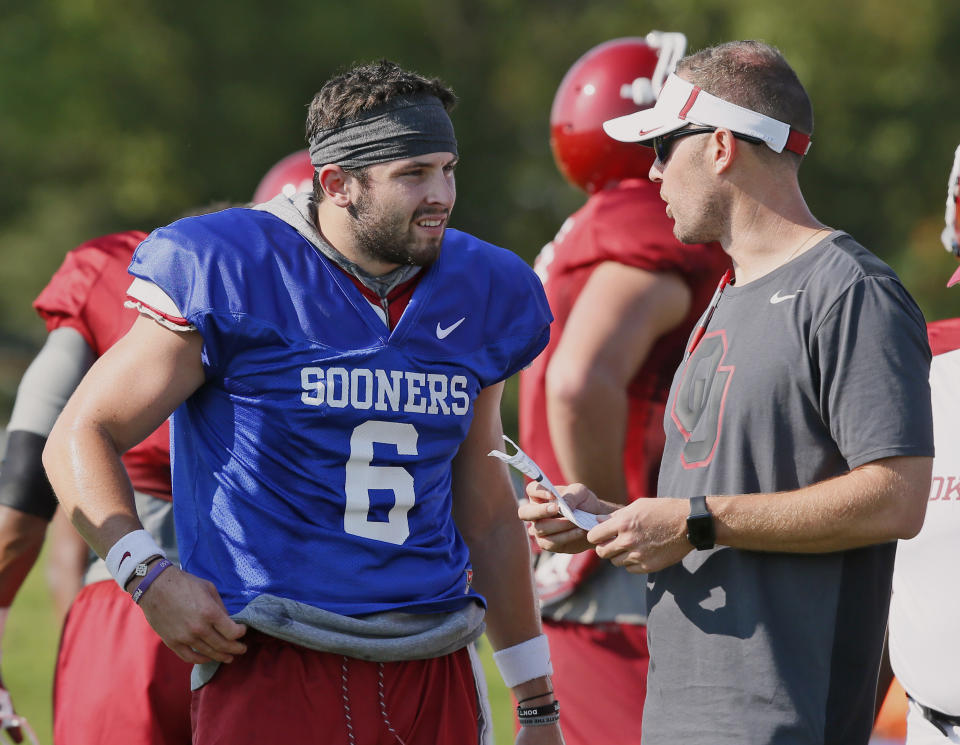
Teams listed in predicted order of finish
Oklahoma (11-1, 9-0 Big 12)
Coming off consecutive Big 12 titles, Oklahoma had to deal with the sudden change of Bob Stoops’ surprise retirement. Stoops handed the reins to offensive coordinator Lincoln Riley. Stoops’ hire of Riley ahead of the 2015 season helped vault the Sooners back to the top of the conference. From the outside looking in, the transition has been pretty seamless.
The Sooners return Heisman finalist Baker Mayfield at quarterback, but have to replace a ton of skill production on that side of the ball. Riley likes the depth of Rodney Anderson and Abdul Adams to step in for Samaje Perine and Joe Mixon at running back, and the Sooners will rely heavily on tight end Mark Andrews in the passing game. Receiver Jeff Badet, a grad transfer from Kentucky, should have plenty of opportunities, too.
When you have a quarterback the caliber of Mayfield, a good line, and Riley running the show, it’s hard to see OU taking much, if any, of a step back offensively. Even if there is a drop off on offense, the Sooners should take a step forward defensively with an improved pass rush and experienced secondary.
The Sooners rolled through the Big 12 with a perfect record in 2016, but missed the CFP because of two non-conference losses. OU has a trip to Ohio State, but has Tulane and UTEP on the slate this year instead of Houston. OU can overcome a slip-up to the Buckeyes and still ably rebound to Playoff contention.
For more on Oklahoma, No. 5 in our Top 25, read our in-depth preview.
Oklahoma State (10-2, 7-2)
If Oklahoma State is going to get back to the top of the conference ahead of the rival Sooners, this has to be the year, right? Almost everybody on one of the most explosive offenses in the country is back, led by QB Mason Rudolph, wideout James Washington and running back Justice Hill. The Cowboys might have the best receiving group in the country. In addition to Washington (one of the nation’s top deep threats), Jalen McCleskey and Chris Lacy return, LSU transfer Tyron Johnson is eligible and Marcell Ateman is back from injury.
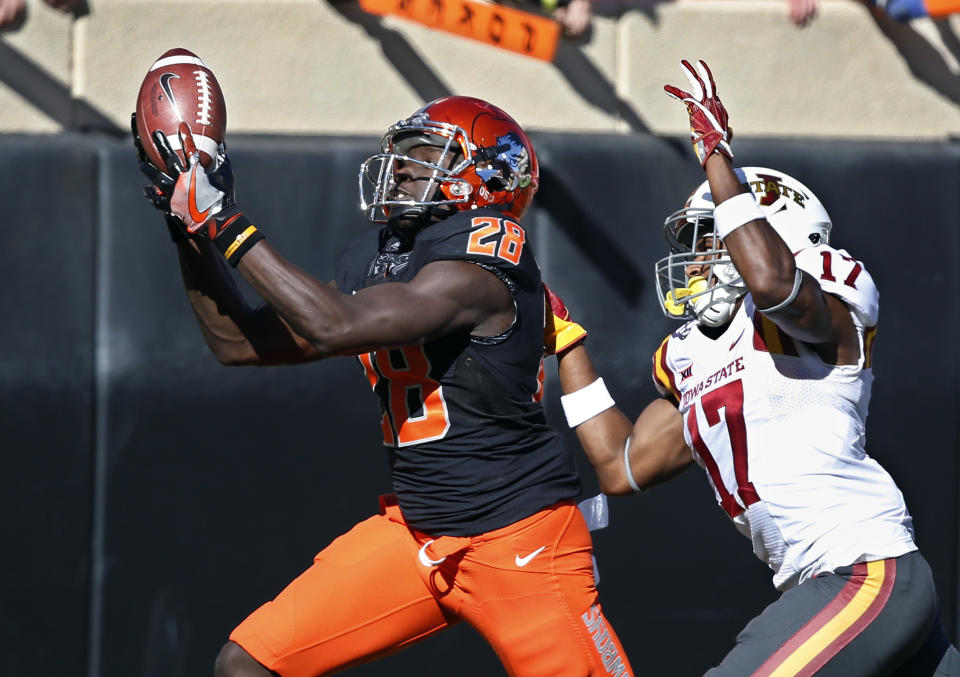
The offense is always good at Oklahoma State, but can the Cowboys stop anybody? That’s the big question in 2017 and there are concerns. The secondary was looking pretty underwhelming, so coach Mike Gundy brought in Adrian Baker, a grad transfer from Clemson, to start at corner to complement Ramon Richards’ move to safety. If the defense improves, OSU will be right there with Oklahoma as a College Football Playoff contender.
Oh, and don’t be surprised to see an Oklahoma-Oklahoma State rematch in the Big 12 title game.
For more on Oklahoma State, No. 7 in our Top 25, read our in-depth preview.
Kansas State (9-3, 6-3)
Kansas State seems to surge past expectations most years. The Wildcats are ranked in most preseason projections this year, so how will Bill Snyder’s group react to the label of possible surprise Big 12 title contender?
KSU had a sluggish 3-3 start in 2016, but quietly rebounded by winning six of its final seven games to finish 9-4, including a Texas Bowl win over Texas A&M. The Wildcats return 14 starters and are especially strong in the trenches — on both sides of the ball — and have Jesse Ertz back from a shoulder injury at quarterback.
Ertz played much of last year with the injury, which severely limited his ability to throw the ball. He’s a big running threat and led KSU with 1,012 yards and 12 touchdowns a year ago. We’re expecting a breakout year from Ertz now that his shoulder is fully healed and his two top wideouts, Byron Pringle and Dominique Heath, are back. Defensively, KSU should have some kinks to work out early in the year because of talent lost to the NFL, but the unit should be solid like most Kansas State defenses.
We’ll know a lot about KSU’s conference chances after its stretch against Baylor, Texas, TCU and Oklahoma in consecutive weekends from Sept. 30 to Oct. 21. All but the UT game are in Manhattan. Win three of those four and the Wildcats can be a surprise contender for the conference crown.
For more on Kansas State, No. 19 in our Top 25, read our in-depth preview.
TCU (8-4, 5-4)
At Big 12 Media Days, Gary Patterson didn’t mince words reflecting on 2016.
“I tell everybody that the good news is we have everybody back, and the bad news is we were 6-6 and we got everybody back,” Patterson said. “So how do you make that work?”
When you’ve been around as long as Patterson, you know how to identify what went wrong and correct things. TCU won a combined 23 games in two seasons before just six last fall. The Horned Frogs should bounce back in 2017, but to what extent? As Patterson noted, the Horned Frogs return the majority of their starters, including QB Kenny Hill. When TCU was at its best in 2014 and 2015, it had Trevone Boykin going nuts on opponents with his arm and legs. Hill, a Texas A&M transfer, was too inconsistent to replicate Boykin’s stellar play. A lot will ride on Hill and the array of skill around him on offense taking a step forward in 2017.
Defense has been Patterson’s calling card, and the Horned Frogs were pretty solid on that side of the ball in 2016. Above all, Patterson wants his team to play with more toughness. They’ll need it in 2017 with such a difficult road schedule. TCU plays Oklahoma State, Kansas State and Oklahoma on the road and travels to Arkansas in the non-con.
Texas (7-5, 5-4)
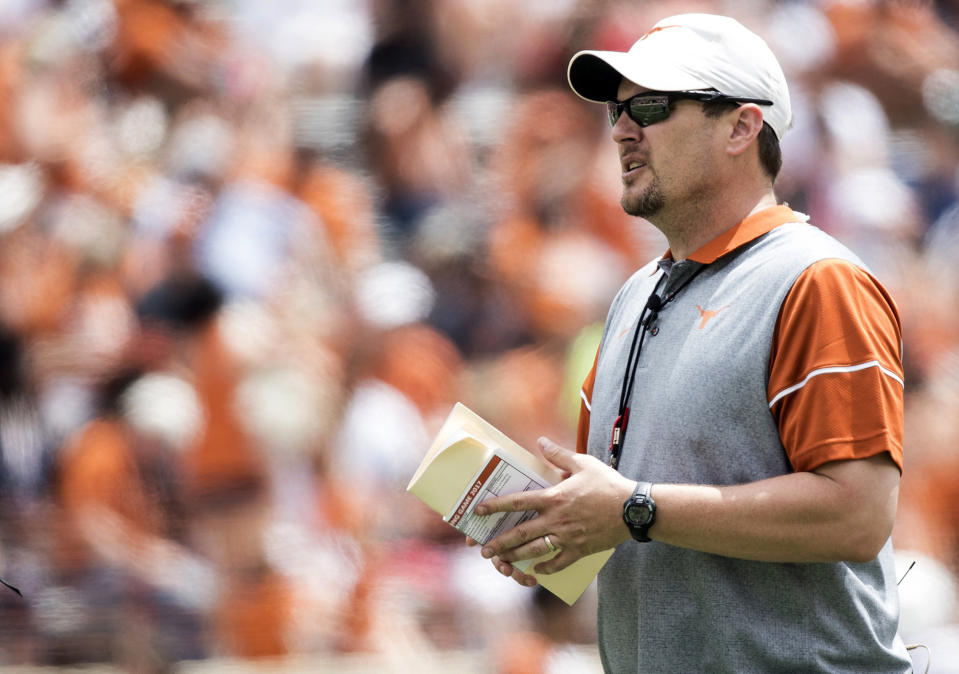
After three straight losing seasons — one of the worst stretches in program history — Texas brought in Tom Herman from Houston to turn things around. Herman inherited a lot of talent, but there’s still a lot of work to be done before the Longhorns are back in the upper echelon of the Big 12.
Herman is familiar with the landscape as a former Longhorns GA, but there’s a lot of work to be done — a lot has already been done — to modernize the program. On the field, there’s a quarterback in place with Shane Buechele, who showed flashes of brilliance with plenty of mistakes mixed in as a freshman in 2016. On defense, UT has the chance to be much improved if it can stay healthy. Herman is worried about the team’s depth.
The job Herman did at Houston shows what he is capable of, but to expect that dramatic of a turnaround in one season seems a little farfetched. This is a bowl team, but the true big leap back to the top of the heap seems like it’s a little further down the road. With the way Herman is recruiting, it’s not too far.
For more on Texas, No. 20 in our Top 25, read our in-depth preview.
West Virginia (6-6, 4-5)
All eyes will be on Will Grier for West Virginia in 2017. The highly-publicized transfer quickly seized the starting quarterback role after his tumultuous exit from Florida. He takes over a WVU team that won 10 games in 2016 but really felt like it overachieved with four of its wins coming by four or fewer points. Grier will be teamed with stellar running back Justin Crawford, but there’s a void at receiver and the line lost three starters. Overall, WVU is low on returning starters and has a really tough schedule with its games against TCU, Kansas State and Oklahoma all on the road and a neutral site opener against Virginia Tech.
There’s even more talent to replace on defense for coordinator Tony Gibson, one of the conference’s best assistants. Safety Dravon Askew-Henry is back from injury to team up with Kyzir White and the linebackers should be solid. The rest of the defense looks like it will be pretty young, especially at cornerback. In the pass-happy Big 12, that’s never a positive.
Baylor (6-6, 4-5)
Coming off the turmoil of the conclusion of the Art Briles era, Baylor made a really nice hire by bringing in Matt Rhule from Temple. In his final two seasons in Philadelphia, Rhule won 10 games in back-to-back seasons, capping it off with the 2016 AAC title. All of the attrition from the Briles fallout puts Rhule in a tough spot depth-wise, especially on the offensive line. Things will look a little different under Rhule on offense, but the Bears should be able to score at a decent clip while boasting one of the more-experienced defenses in the conference.
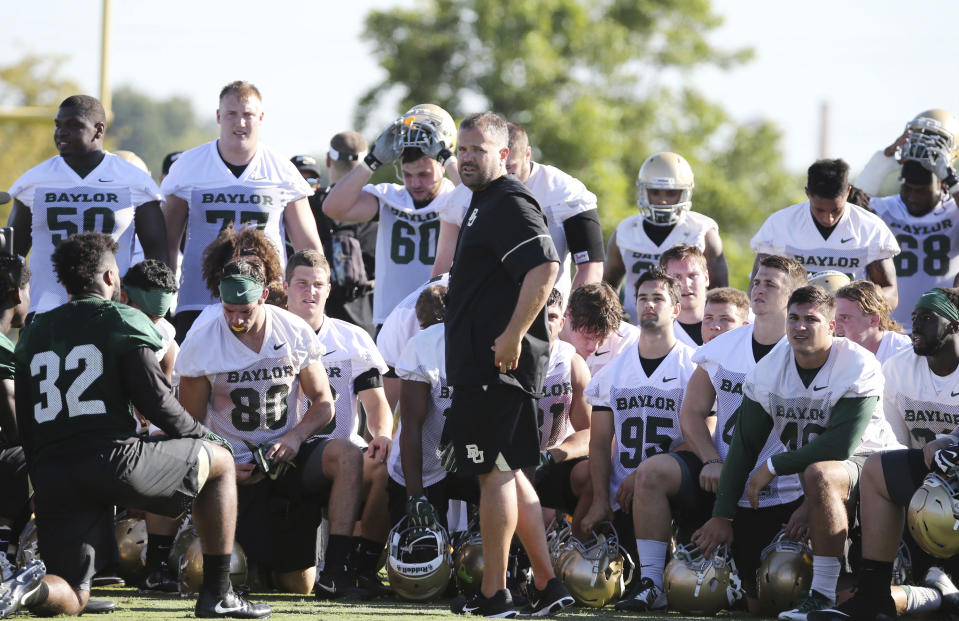
The non-conference schedule (Liberty, UTSA and Duke) should allow the Bears to get some early-season wins under their belt before a brutal stretch — Oklahoma, at Kansas State, at Oklahoma State, West Virginia, at Texas — to begin conference play. There won’t be many wins to find during that portion of the schedule, but the Bears can creep toward a bowl berth by handling Kansas, Texas Tech and Iowa State late in the year. And don’t be surprised if the Bears pull off an upset somewhere along the way.
Iowa State (4-8, 2-7)
Matt Campbell has Iowa State on an upward trajectory. ISU had a bunch of close losses in 2016 before finishing the year by winning two of three down the stretch to finish 3-9. On offense, the Cyclones have one of the better QB-WR duos in the conference with Jacob Park and Allen Lazard, who has 170 career receptions. On defense, five of the team’s top six tacklers return and former starting quarterback Joel Lanning is now the starter at middle linebacker. If he can flourish on defense, it’ll be one of the cooler stories in college football.
Iowa State is a tough place to win. The Cyclones haven’t won more than three games in a season since 2012. We’ve got the Cyclones marked down for four wins in 2017. It could be five if ISU upsets rival Iowa at home in Week 2. That game will be much, much closer than last year’s 42-3 decision in Iowa City.
Texas Tech (3-9, 1-8)
Texas Tech hasn’t shown much evidence it will be any better than it was last year when it went 5-7 with first-round pick Patrick Mahomes at quarterback. Nic Shimonek, a senior and Mahomes’ two-year backup, will put up big numbers (despite the loss of leading receiver Jonathan Giles to transfer) like most Red Raiders quarterbacks do, but will it be enough to make up for the team’s consistently shoddy defense? Doubtful.
Even if TTU matches its 3-6 Big 12 record from 2016, a bowl trip looks unlikely with teams like Arizona State and Houston on its non-conference schedule. This may end up being Kliff Kingsbury’s final season as head coach of his alma mater.
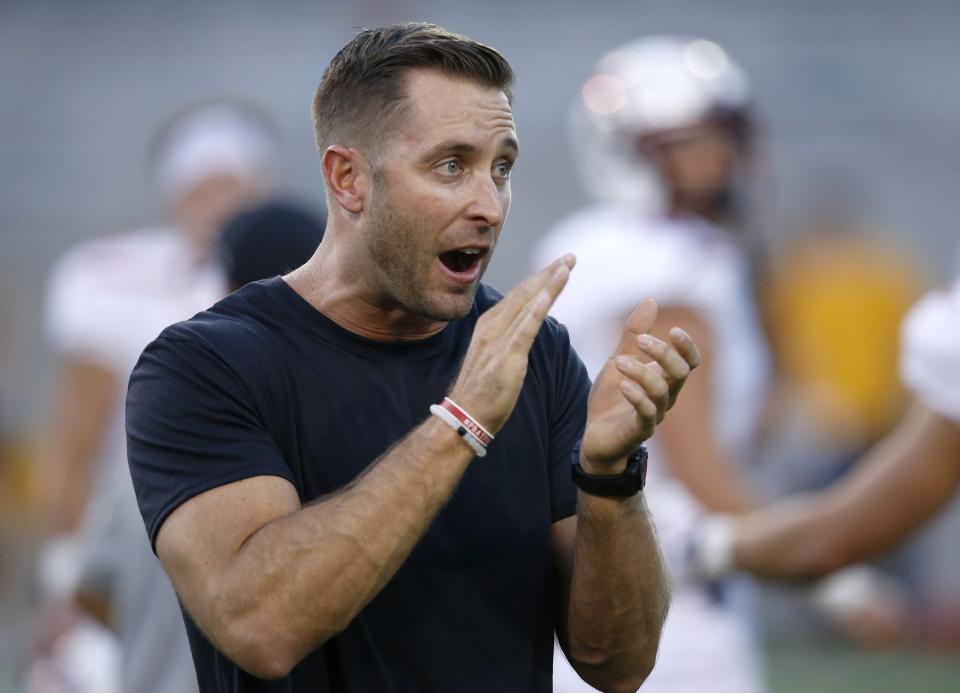
Kansas (3-9, 0-9)
David Beaty inherited maybe the most difficult rebuilding job in the country and it showed in his first two seasons’ records: 0-12 and 2-10. That doesn’t mean he’s not doing a good job. Things are on the right path compared to where things were in Lawrence when Charlie Weis was fired. There is legitimate Big 12 talent on this team, led by defensive end Dorance Armstrong, a potential conference defensive player of the year and first-round pick.
The Jayhawks have the chance to surpass last year’s win total in the non-conference portion of the schedule (Southeastern Missouri, Central Michigan, Ohio) alone. With the way the rest of the schedule lays out, we have a hard time finding identifying where this year’s Big 12 upset will come. At the very least, Kansas will continue to be far more competitive than it was in years past, especially with improved quarterback play.
More college football from Yahoo Sports:
– – – – – – –
Sam Cooper is a writer for the Yahoo Sports blogs. Have a tip? Email him or follow him on Twitter!

